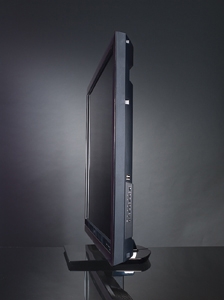Sony KDL-52W5100

| Key Features |
| Price $1,699.99 (Web) Sonystyle.com |
| • Motionflow 120-Hz processing • Bravia Internet Video/ Widget access • DLNA-compatible for photo, music, and video streaming • Network-connected TV Guide program guide • XrossMediaBar (XMB) menu system • Bravia Engine 3 video processor • Bravia Sync HDMI (CEC) control • Inputs: (4) HDMI, (2) component video, composite-/S-video, HD-15 pin RGB, RF antenna/cable, USB, Ethernet • Outputs: Analog stereo audio, optical digital audio • Dimensions Weight 487?8 x 323?8 x 141?8 (with stand); 66 lb (with stand) |
Dating back from the days before HDTV, Sony's XBR Series televisions have been something of a gold standard among videophiles, with a price tag to match. But what if an XBR is too rich for your budget? The 52-inch model KDL-52W5100 sits right in the middle of Sony's LCD hierarchy. With a list price of $2,099.99 (Web price: a more affordable $1,699.99), it faces some serious flat-panel competition. So how does it stack up?
Cosmetically, this Sony is a basic black frame spruced up with a layer of clear Lucite over the bezel and the top of its (non-swiveling) rectangular base. The Sony logo below the screen glows white when the TV is on, though it can thankfully be turned off in the menu. Good-size speakers (for a flat-panel, anyway) project down from the bottom on either side, and I was pleased to find that they could deliver loud, undistorted sound effects and dialogue on movies in my welldamped viewing room.
There are plenty of connections on the 52W5100. Sony cleverly put three of the four HDMI ports in the left sidefacing convenience jack pack, where they're more accessible when the TV is wall-mounted or for making temporary connection of digital camcorders, game consoles, and other devices that might use HDMI. The same jack pack houses a composite-/S-video input, a USB port for photos or music, and a 15-pin RGB input for a computer.Rear-facing inputs include the remaining HDMI jack (this one with stereo audio for connecting DVI sources with an adapter), two component-video jacks, and an Ethernet port.
That last connection is for tapping into Sony's Internet content partners or a DLNA-certified media server. After hooking the TV up to my network router, I was impressed with the wealth of offerings accessible from the onscreen menu. These include not only the increasingly common Netflix, Amazon Video on Demand, and YouTube but many other free and paid services - 25 in all. In aggregate, this trove begins to make good on the promise of networkconnected TV.
Thoughtfully, both the Internet video menu and Yahoo! Widgets for weather or stocks can be called up through some centrally placed buttons on the straightforward remote control. The remote's keypad lacks backlighting, but its well-placed navigation cluster and large menu button simplifies operation in the dark. On the other hand, Sony put the important volume, channel, and mute buttons near the bottom, inconveniently out of thumb's reach. A Wide button changes the aspect ratios. For HD signals, these include a Full mode with about 3% picture overscan and a Full Pixel option that perfectly matches 1080i- and 1080p-format programs to the screen's native resolution.
This TV also includes a TV Guidebranded interactive program guide for use with straight cable or antenna hookups. Although it's advertiser-supported, with banners and ads that you might see on a Web site, the program information populated quickly via the TV's Internet connection and I found it to be an effective alternative to a traditional cable-box guide.
| SETUP The 52W5100's 11 picture presets are broken out as either Picture Modes or Scenes. The Scenes menu, which includes options like Cinema, Sports, Photo, and Game, can be accessed on the fly from the remote. Each scene also provides memory to store custom picture settings for each source connected to the TV. The Cinema scene, with its default Warm2 color temperature, looked the most accurate out of the box, so that's the one I settled on for my evaluation. Fine-tuning the white balance with the user menu controls was a challenge due to the set's non-linear grayscale tracking, but with enough time I reached a livable compromise (see Test Bench). Some mild oversaturation of reds and greens also resulted in my turning down the color control a bit to bring things in line. |  |
|---|
Except for a menu option called Advanced Contrast Enhancer, all of the Sony's automatic picture controls were inactive by default on the Cinema scene selection. But I spent some time experimenting with this and the others. The Clear White option introduced grayscale inaccuracy by boosting the set's color temperature toward blue on brighter scenes. The Live Color option boosted saturation and made the colors, especially red, look cartoony. The Advanced Contrast Enhancer had the effect of boosting the brightness of near-blacks while leaving the darkest black untouched, giving the impression of blacker blacks without actually delivering them. And the Black Corrector made the nearblacks blacker, effectively crushing shadow detail. I left all of these off, though I moved the Gamma control up a notch from its default position.
The Noise Reduction and MPEG NR settings were mostly left off. The Cinemotion feature, which enables 3:2 pulldown for film-based content, was left on, while Motionflow, which works with the 120-Hz refresh feature, was either left off or used in its Standard setting when the content might benefit from it, such as while I was watching NFL football. While Motionflow was effective in smoothing the motion from horizontal camera pans and improving the clarity of fast-moving objects, its High setting imparted an obvious "video look" to programs originally shot on film.
- Log in or register to post comments




















































